Analysis of Adani Coal Mine using Stakeholder Theory: ACC620 Project
VerifiedAdded on 2022/11/07
|12
|2279
|335
Report
AI Summary
This report provides a comprehensive analysis of the Adani coal mine project in Queensland, focusing on the application of stakeholder theory. It begins with an explanation of stakeholder theory and then identifies and analyzes three key stakeholder groups affected by the mine's operations: employees, the government, and citizens, in addition to the indigenous community. The report explores the ethical considerations involved in managing the interests of the indigenous community, emphasizing the need for sustainable solutions and the importance of incorporating their perspectives. It then applies stakeholder theory to assess how the interests of these groups have been and should be managed, considering both present and future requirements. The report highlights the conflicts between economic progress and environmental concerns and suggests ways to balance these competing interests, promoting ethical practices and sustainable development. The analysis underscores the importance of stakeholder engagement, ethical decision-making, and the need for the Australian government to enforce environmental regulations while ensuring local communities are provided with livelihood assistance. The study emphasizes the significance of the indigenous community's role in developing sustainable goals and promoting responsible corporate behavior.
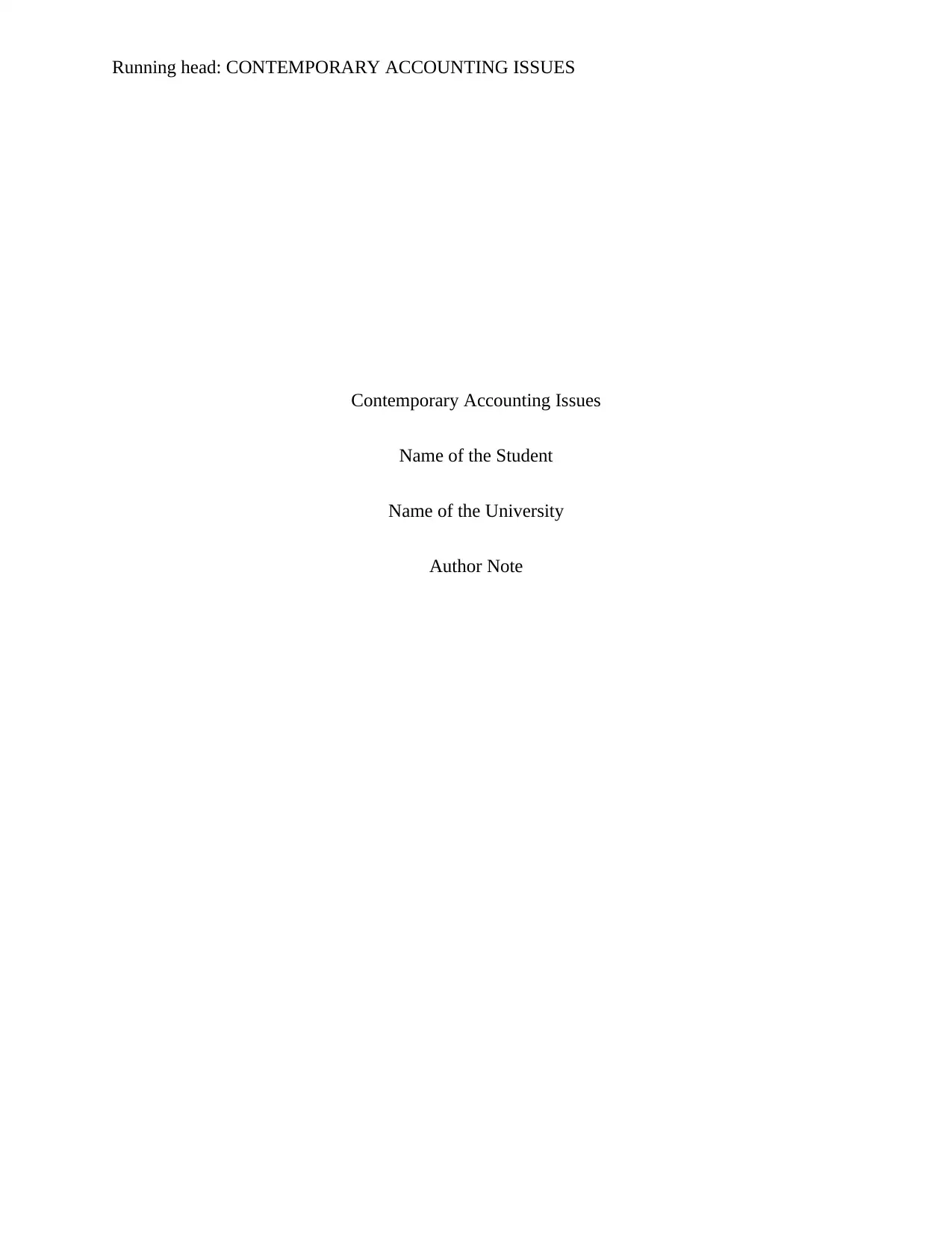
Running head: CONTEMPORARY ACCOUNTING ISSUES
Contemporary Accounting Issues
Name of the Student
Name of the University
Author Note
Contemporary Accounting Issues
Name of the Student
Name of the University
Author Note
Paraphrase This Document
Need a fresh take? Get an instant paraphrase of this document with our AI Paraphraser
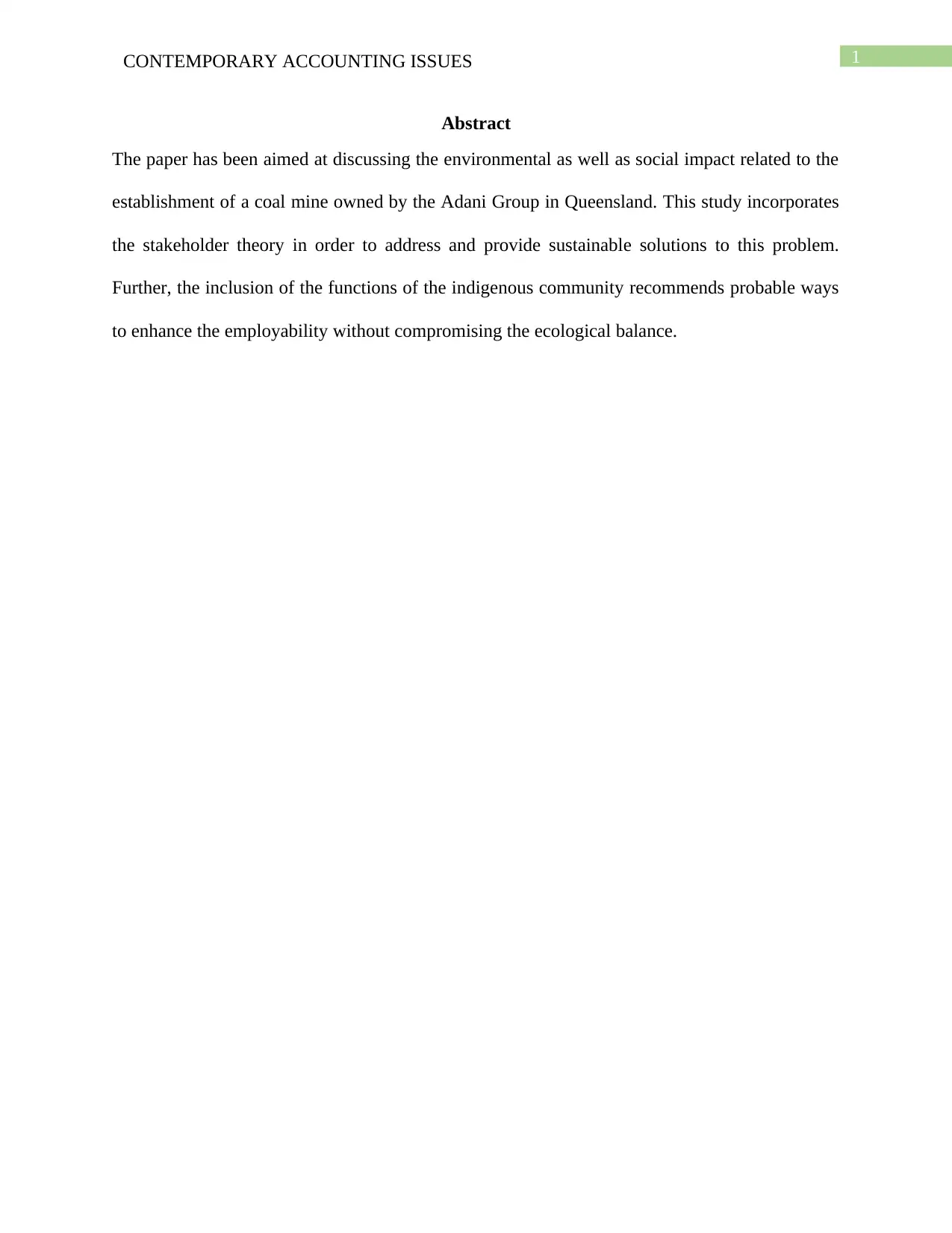
1CONTEMPORARY ACCOUNTING ISSUES
Abstract
The paper has been aimed at discussing the environmental as well as social impact related to the
establishment of a coal mine owned by the Adani Group in Queensland. This study incorporates
the stakeholder theory in order to address and provide sustainable solutions to this problem.
Further, the inclusion of the functions of the indigenous community recommends probable ways
to enhance the employability without compromising the ecological balance.
Abstract
The paper has been aimed at discussing the environmental as well as social impact related to the
establishment of a coal mine owned by the Adani Group in Queensland. This study incorporates
the stakeholder theory in order to address and provide sustainable solutions to this problem.
Further, the inclusion of the functions of the indigenous community recommends probable ways
to enhance the employability without compromising the ecological balance.
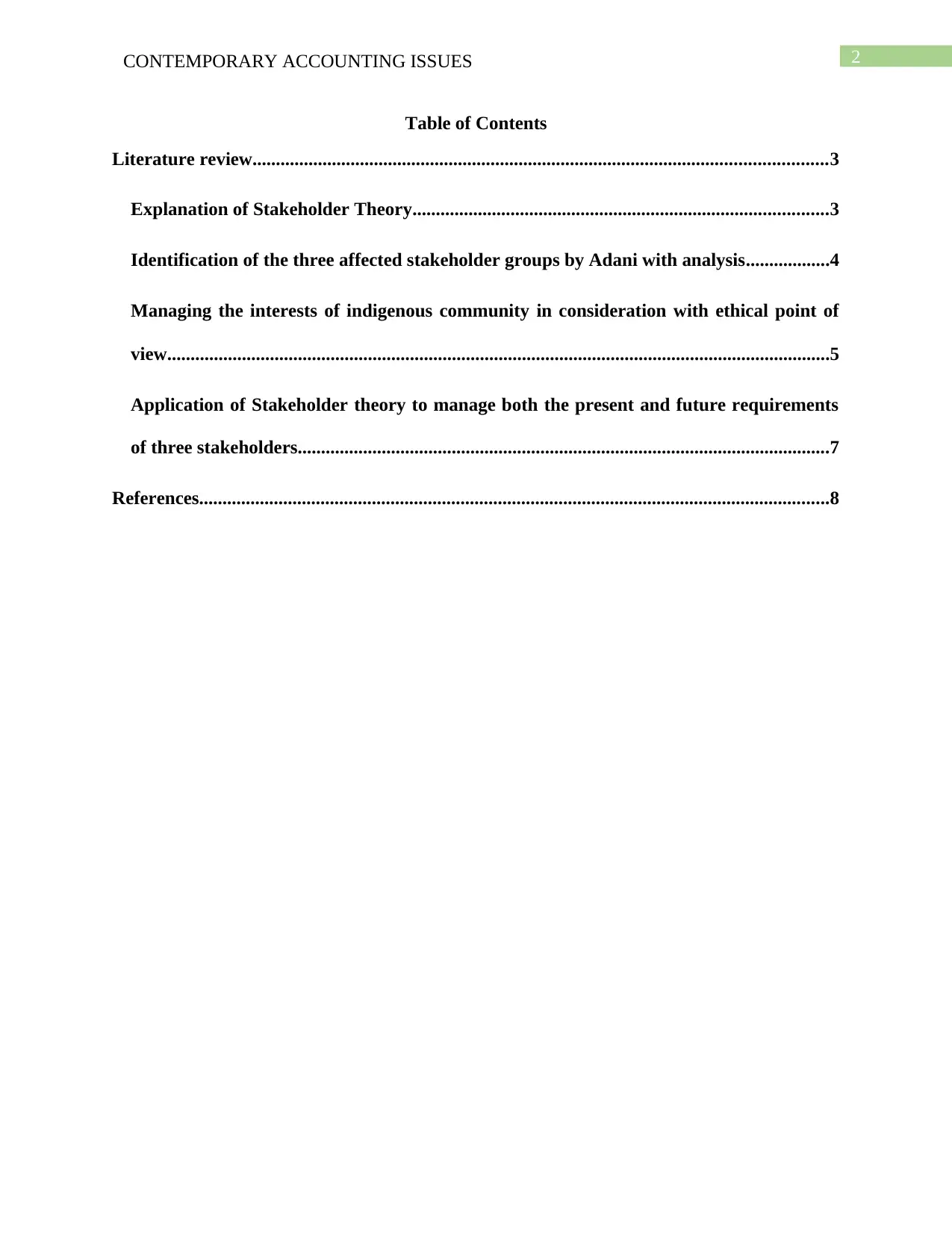
2CONTEMPORARY ACCOUNTING ISSUES
Table of Contents
Literature review...........................................................................................................................3
Explanation of Stakeholder Theory.........................................................................................3
Identification of the three affected stakeholder groups by Adani with analysis..................4
Managing the interests of indigenous community in consideration with ethical point of
view..............................................................................................................................................5
Application of Stakeholder theory to manage both the present and future requirements
of three stakeholders..................................................................................................................7
References.......................................................................................................................................8
Table of Contents
Literature review...........................................................................................................................3
Explanation of Stakeholder Theory.........................................................................................3
Identification of the three affected stakeholder groups by Adani with analysis..................4
Managing the interests of indigenous community in consideration with ethical point of
view..............................................................................................................................................5
Application of Stakeholder theory to manage both the present and future requirements
of three stakeholders..................................................................................................................7
References.......................................................................................................................................8
⊘ This is a preview!⊘
Do you want full access?
Subscribe today to unlock all pages.

Trusted by 1+ million students worldwide
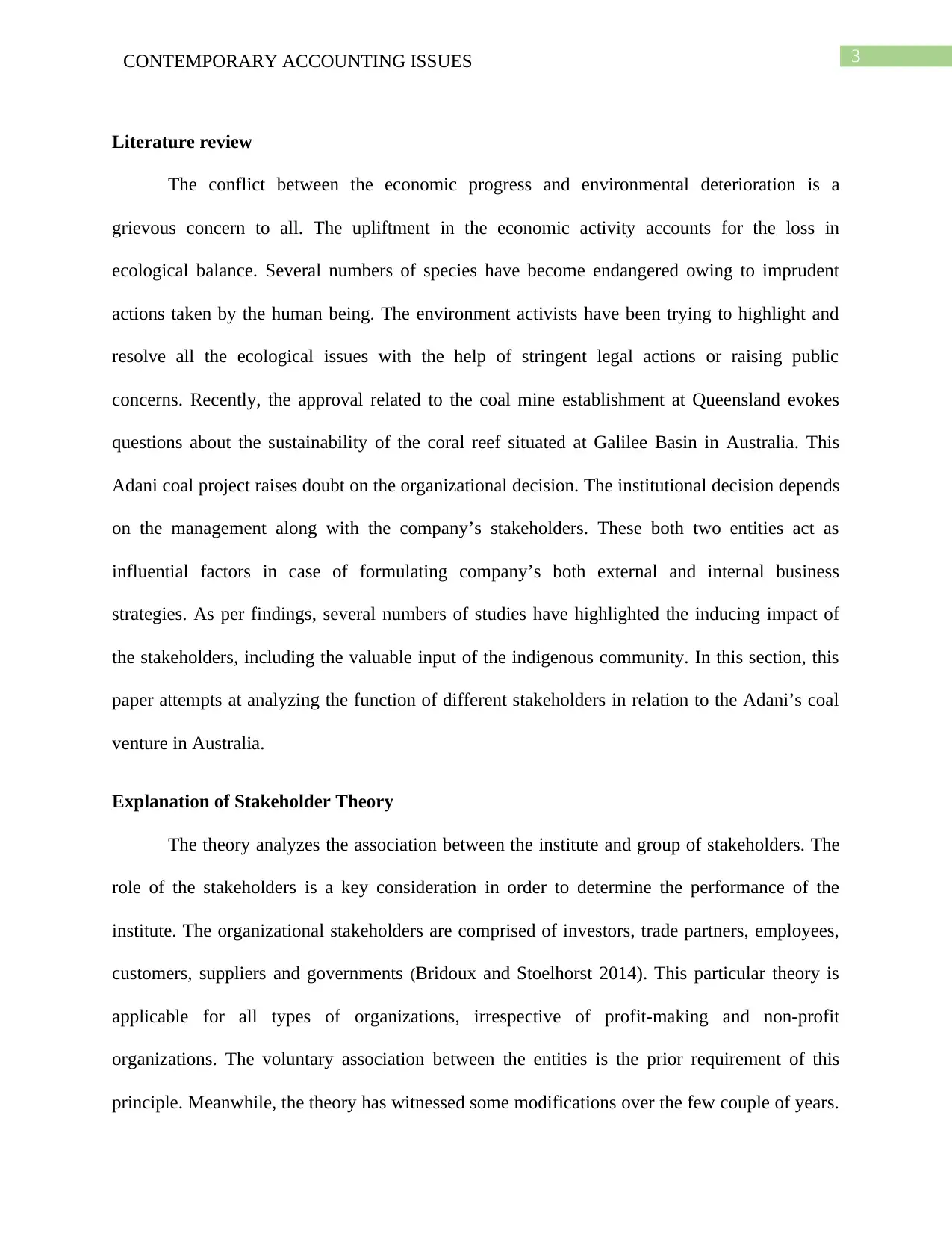
3CONTEMPORARY ACCOUNTING ISSUES
Literature review
The conflict between the economic progress and environmental deterioration is a
grievous concern to all. The upliftment in the economic activity accounts for the loss in
ecological balance. Several numbers of species have become endangered owing to imprudent
actions taken by the human being. The environment activists have been trying to highlight and
resolve all the ecological issues with the help of stringent legal actions or raising public
concerns. Recently, the approval related to the coal mine establishment at Queensland evokes
questions about the sustainability of the coral reef situated at Galilee Basin in Australia. This
Adani coal project raises doubt on the organizational decision. The institutional decision depends
on the management along with the company’s stakeholders. These both two entities act as
influential factors in case of formulating company’s both external and internal business
strategies. As per findings, several numbers of studies have highlighted the inducing impact of
the stakeholders, including the valuable input of the indigenous community. In this section, this
paper attempts at analyzing the function of different stakeholders in relation to the Adani’s coal
venture in Australia.
Explanation of Stakeholder Theory
The theory analyzes the association between the institute and group of stakeholders. The
role of the stakeholders is a key consideration in order to determine the performance of the
institute. The organizational stakeholders are comprised of investors, trade partners, employees,
customers, suppliers and governments (Bridoux and Stoelhorst 2014). This particular theory is
applicable for all types of organizations, irrespective of profit-making and non-profit
organizations. The voluntary association between the entities is the prior requirement of this
principle. Meanwhile, the theory has witnessed some modifications over the few couple of years.
Literature review
The conflict between the economic progress and environmental deterioration is a
grievous concern to all. The upliftment in the economic activity accounts for the loss in
ecological balance. Several numbers of species have become endangered owing to imprudent
actions taken by the human being. The environment activists have been trying to highlight and
resolve all the ecological issues with the help of stringent legal actions or raising public
concerns. Recently, the approval related to the coal mine establishment at Queensland evokes
questions about the sustainability of the coral reef situated at Galilee Basin in Australia. This
Adani coal project raises doubt on the organizational decision. The institutional decision depends
on the management along with the company’s stakeholders. These both two entities act as
influential factors in case of formulating company’s both external and internal business
strategies. As per findings, several numbers of studies have highlighted the inducing impact of
the stakeholders, including the valuable input of the indigenous community. In this section, this
paper attempts at analyzing the function of different stakeholders in relation to the Adani’s coal
venture in Australia.
Explanation of Stakeholder Theory
The theory analyzes the association between the institute and group of stakeholders. The
role of the stakeholders is a key consideration in order to determine the performance of the
institute. The organizational stakeholders are comprised of investors, trade partners, employees,
customers, suppliers and governments (Bridoux and Stoelhorst 2014). This particular theory is
applicable for all types of organizations, irrespective of profit-making and non-profit
organizations. The voluntary association between the entities is the prior requirement of this
principle. Meanwhile, the theory has witnessed some modifications over the few couple of years.
Paraphrase This Document
Need a fresh take? Get an instant paraphrase of this document with our AI Paraphraser
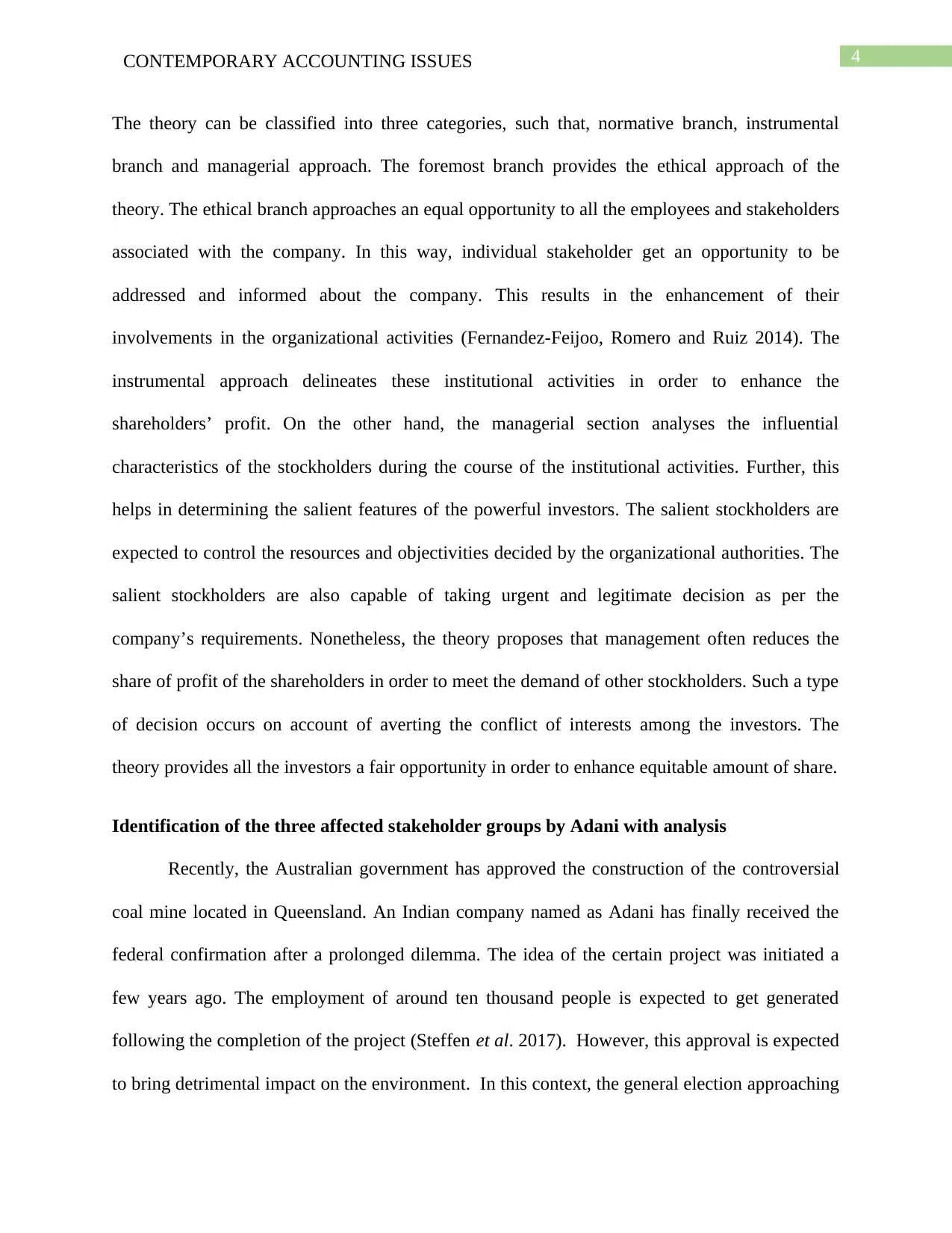
4CONTEMPORARY ACCOUNTING ISSUES
The theory can be classified into three categories, such that, normative branch, instrumental
branch and managerial approach. The foremost branch provides the ethical approach of the
theory. The ethical branch approaches an equal opportunity to all the employees and stakeholders
associated with the company. In this way, individual stakeholder get an opportunity to be
addressed and informed about the company. This results in the enhancement of their
involvements in the organizational activities (Fernandez-Feijoo, Romero and Ruiz 2014). The
instrumental approach delineates these institutional activities in order to enhance the
shareholders’ profit. On the other hand, the managerial section analyses the influential
characteristics of the stockholders during the course of the institutional activities. Further, this
helps in determining the salient features of the powerful investors. The salient stockholders are
expected to control the resources and objectivities decided by the organizational authorities. The
salient stockholders are also capable of taking urgent and legitimate decision as per the
company’s requirements. Nonetheless, the theory proposes that management often reduces the
share of profit of the shareholders in order to meet the demand of other stockholders. Such a type
of decision occurs on account of averting the conflict of interests among the investors. The
theory provides all the investors a fair opportunity in order to enhance equitable amount of share.
Identification of the three affected stakeholder groups by Adani with analysis
Recently, the Australian government has approved the construction of the controversial
coal mine located in Queensland. An Indian company named as Adani has finally received the
federal confirmation after a prolonged dilemma. The idea of the certain project was initiated a
few years ago. The employment of around ten thousand people is expected to get generated
following the completion of the project (Steffen et al. 2017). However, this approval is expected
to bring detrimental impact on the environment. In this context, the general election approaching
The theory can be classified into three categories, such that, normative branch, instrumental
branch and managerial approach. The foremost branch provides the ethical approach of the
theory. The ethical branch approaches an equal opportunity to all the employees and stakeholders
associated with the company. In this way, individual stakeholder get an opportunity to be
addressed and informed about the company. This results in the enhancement of their
involvements in the organizational activities (Fernandez-Feijoo, Romero and Ruiz 2014). The
instrumental approach delineates these institutional activities in order to enhance the
shareholders’ profit. On the other hand, the managerial section analyses the influential
characteristics of the stockholders during the course of the institutional activities. Further, this
helps in determining the salient features of the powerful investors. The salient stockholders are
expected to control the resources and objectivities decided by the organizational authorities. The
salient stockholders are also capable of taking urgent and legitimate decision as per the
company’s requirements. Nonetheless, the theory proposes that management often reduces the
share of profit of the shareholders in order to meet the demand of other stockholders. Such a type
of decision occurs on account of averting the conflict of interests among the investors. The
theory provides all the investors a fair opportunity in order to enhance equitable amount of share.
Identification of the three affected stakeholder groups by Adani with analysis
Recently, the Australian government has approved the construction of the controversial
coal mine located in Queensland. An Indian company named as Adani has finally received the
federal confirmation after a prolonged dilemma. The idea of the certain project was initiated a
few years ago. The employment of around ten thousand people is expected to get generated
following the completion of the project (Steffen et al. 2017). However, this approval is expected
to bring detrimental impact on the environment. In this context, the general election approaching
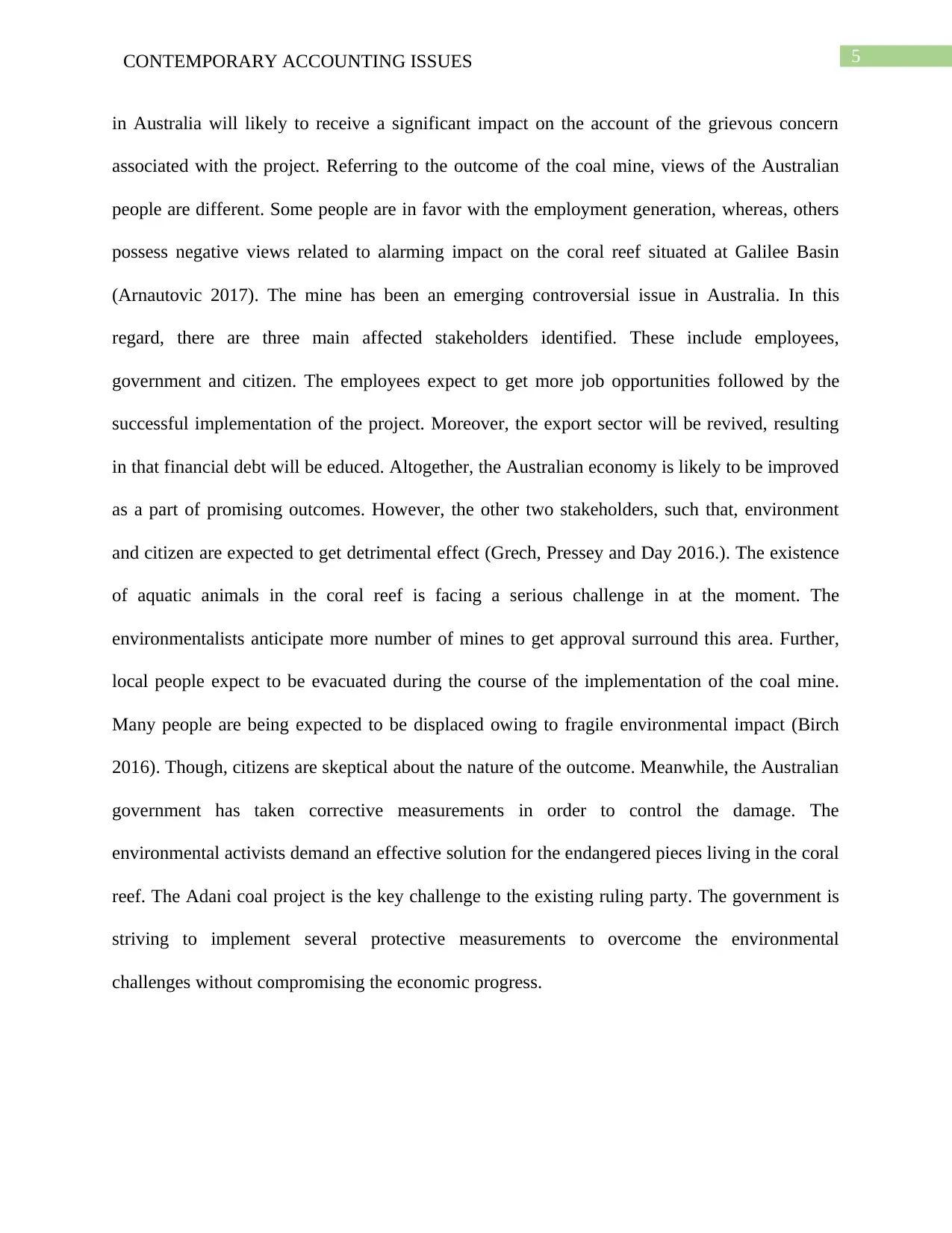
5CONTEMPORARY ACCOUNTING ISSUES
in Australia will likely to receive a significant impact on the account of the grievous concern
associated with the project. Referring to the outcome of the coal mine, views of the Australian
people are different. Some people are in favor with the employment generation, whereas, others
possess negative views related to alarming impact on the coral reef situated at Galilee Basin
(Arnautovic 2017). The mine has been an emerging controversial issue in Australia. In this
regard, there are three main affected stakeholders identified. These include employees,
government and citizen. The employees expect to get more job opportunities followed by the
successful implementation of the project. Moreover, the export sector will be revived, resulting
in that financial debt will be educed. Altogether, the Australian economy is likely to be improved
as a part of promising outcomes. However, the other two stakeholders, such that, environment
and citizen are expected to get detrimental effect (Grech, Pressey and Day 2016.). The existence
of aquatic animals in the coral reef is facing a serious challenge in at the moment. The
environmentalists anticipate more number of mines to get approval surround this area. Further,
local people expect to be evacuated during the course of the implementation of the coal mine.
Many people are being expected to be displaced owing to fragile environmental impact (Birch
2016). Though, citizens are skeptical about the nature of the outcome. Meanwhile, the Australian
government has taken corrective measurements in order to control the damage. The
environmental activists demand an effective solution for the endangered pieces living in the coral
reef. The Adani coal project is the key challenge to the existing ruling party. The government is
striving to implement several protective measurements to overcome the environmental
challenges without compromising the economic progress.
in Australia will likely to receive a significant impact on the account of the grievous concern
associated with the project. Referring to the outcome of the coal mine, views of the Australian
people are different. Some people are in favor with the employment generation, whereas, others
possess negative views related to alarming impact on the coral reef situated at Galilee Basin
(Arnautovic 2017). The mine has been an emerging controversial issue in Australia. In this
regard, there are three main affected stakeholders identified. These include employees,
government and citizen. The employees expect to get more job opportunities followed by the
successful implementation of the project. Moreover, the export sector will be revived, resulting
in that financial debt will be educed. Altogether, the Australian economy is likely to be improved
as a part of promising outcomes. However, the other two stakeholders, such that, environment
and citizen are expected to get detrimental effect (Grech, Pressey and Day 2016.). The existence
of aquatic animals in the coral reef is facing a serious challenge in at the moment. The
environmentalists anticipate more number of mines to get approval surround this area. Further,
local people expect to be evacuated during the course of the implementation of the coal mine.
Many people are being expected to be displaced owing to fragile environmental impact (Birch
2016). Though, citizens are skeptical about the nature of the outcome. Meanwhile, the Australian
government has taken corrective measurements in order to control the damage. The
environmental activists demand an effective solution for the endangered pieces living in the coral
reef. The Adani coal project is the key challenge to the existing ruling party. The government is
striving to implement several protective measurements to overcome the environmental
challenges without compromising the economic progress.
⊘ This is a preview!⊘
Do you want full access?
Subscribe today to unlock all pages.

Trusted by 1+ million students worldwide
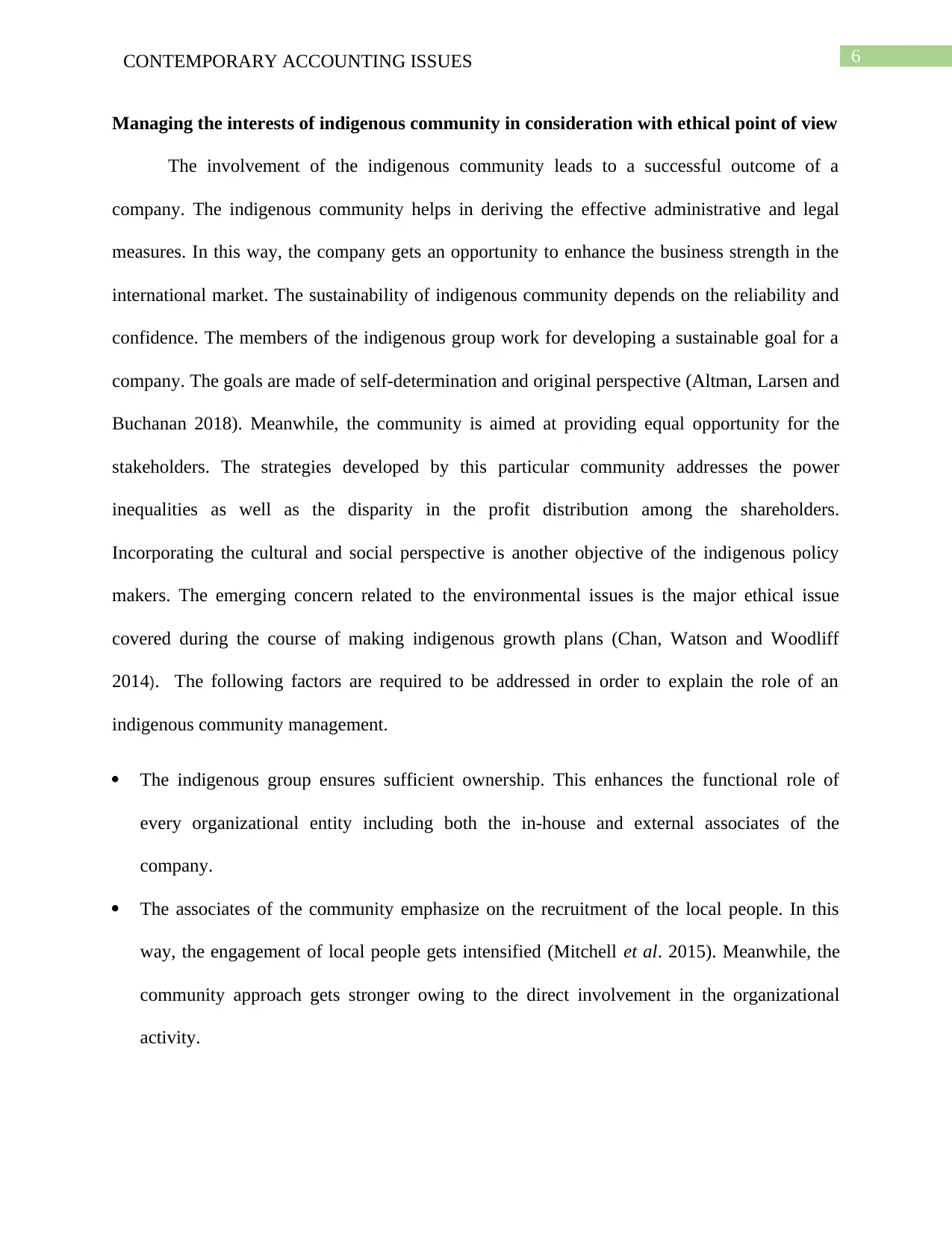
6CONTEMPORARY ACCOUNTING ISSUES
Managing the interests of indigenous community in consideration with ethical point of view
The involvement of the indigenous community leads to a successful outcome of a
company. The indigenous community helps in deriving the effective administrative and legal
measures. In this way, the company gets an opportunity to enhance the business strength in the
international market. The sustainability of indigenous community depends on the reliability and
confidence. The members of the indigenous group work for developing a sustainable goal for a
company. The goals are made of self-determination and original perspective (Altman, Larsen and
Buchanan 2018). Meanwhile, the community is aimed at providing equal opportunity for the
stakeholders. The strategies developed by this particular community addresses the power
inequalities as well as the disparity in the profit distribution among the shareholders.
Incorporating the cultural and social perspective is another objective of the indigenous policy
makers. The emerging concern related to the environmental issues is the major ethical issue
covered during the course of making indigenous growth plans (Chan, Watson and Woodliff
2014). The following factors are required to be addressed in order to explain the role of an
indigenous community management.
The indigenous group ensures sufficient ownership. This enhances the functional role of
every organizational entity including both the in-house and external associates of the
company.
The associates of the community emphasize on the recruitment of the local people. In this
way, the engagement of local people gets intensified (Mitchell et al. 2015). Meanwhile, the
community approach gets stronger owing to the direct involvement in the organizational
activity.
Managing the interests of indigenous community in consideration with ethical point of view
The involvement of the indigenous community leads to a successful outcome of a
company. The indigenous community helps in deriving the effective administrative and legal
measures. In this way, the company gets an opportunity to enhance the business strength in the
international market. The sustainability of indigenous community depends on the reliability and
confidence. The members of the indigenous group work for developing a sustainable goal for a
company. The goals are made of self-determination and original perspective (Altman, Larsen and
Buchanan 2018). Meanwhile, the community is aimed at providing equal opportunity for the
stakeholders. The strategies developed by this particular community addresses the power
inequalities as well as the disparity in the profit distribution among the shareholders.
Incorporating the cultural and social perspective is another objective of the indigenous policy
makers. The emerging concern related to the environmental issues is the major ethical issue
covered during the course of making indigenous growth plans (Chan, Watson and Woodliff
2014). The following factors are required to be addressed in order to explain the role of an
indigenous community management.
The indigenous group ensures sufficient ownership. This enhances the functional role of
every organizational entity including both the in-house and external associates of the
company.
The associates of the community emphasize on the recruitment of the local people. In this
way, the engagement of local people gets intensified (Mitchell et al. 2015). Meanwhile, the
community approach gets stronger owing to the direct involvement in the organizational
activity.
Paraphrase This Document
Need a fresh take? Get an instant paraphrase of this document with our AI Paraphraser
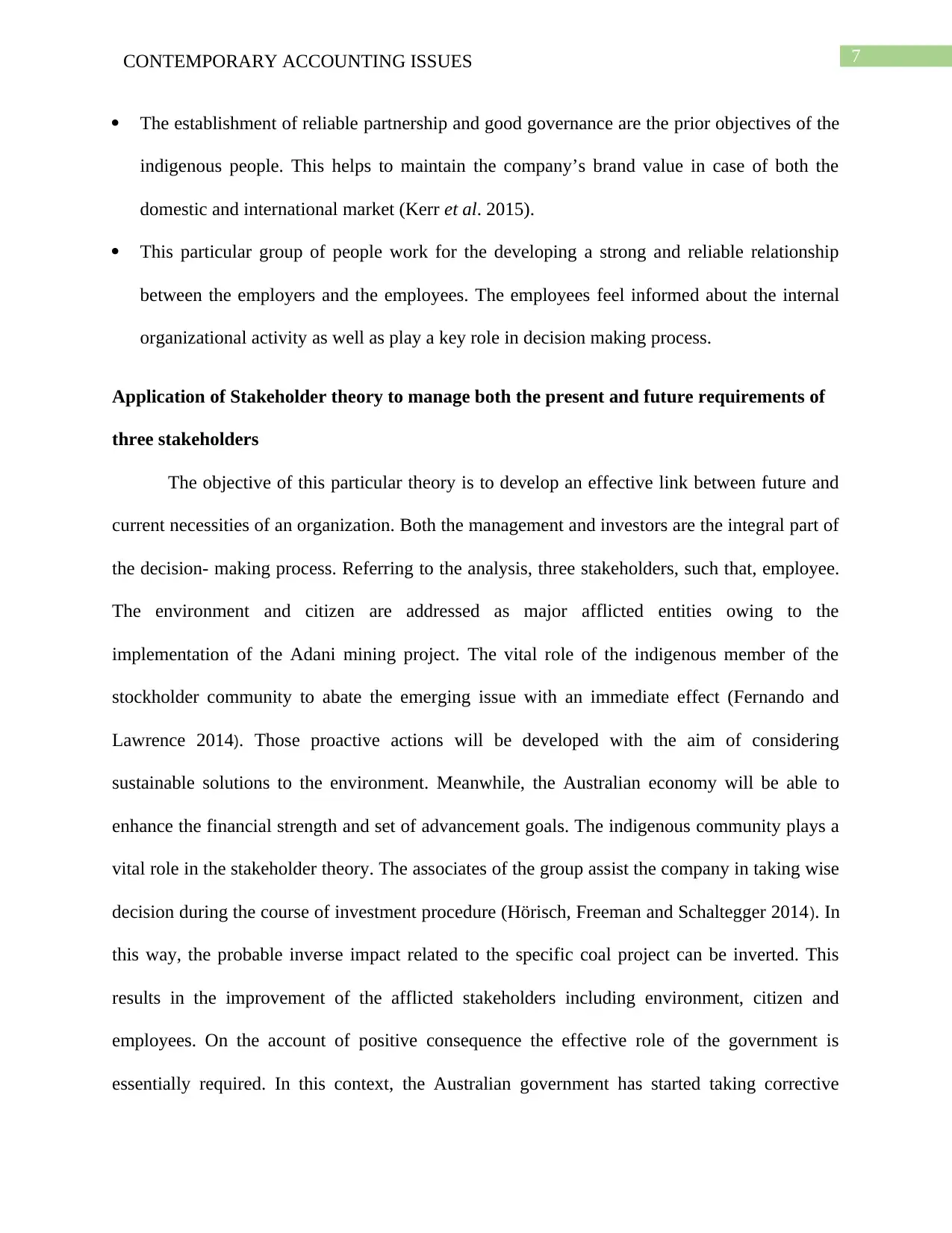
7CONTEMPORARY ACCOUNTING ISSUES
The establishment of reliable partnership and good governance are the prior objectives of the
indigenous people. This helps to maintain the company’s brand value in case of both the
domestic and international market (Kerr et al. 2015).
This particular group of people work for the developing a strong and reliable relationship
between the employers and the employees. The employees feel informed about the internal
organizational activity as well as play a key role in decision making process.
Application of Stakeholder theory to manage both the present and future requirements of
three stakeholders
The objective of this particular theory is to develop an effective link between future and
current necessities of an organization. Both the management and investors are the integral part of
the decision- making process. Referring to the analysis, three stakeholders, such that, employee.
The environment and citizen are addressed as major afflicted entities owing to the
implementation of the Adani mining project. The vital role of the indigenous member of the
stockholder community to abate the emerging issue with an immediate effect (Fernando and
Lawrence 2014). Those proactive actions will be developed with the aim of considering
sustainable solutions to the environment. Meanwhile, the Australian economy will be able to
enhance the financial strength and set of advancement goals. The indigenous community plays a
vital role in the stakeholder theory. The associates of the group assist the company in taking wise
decision during the course of investment procedure (Hörisch, Freeman and Schaltegger 2014). In
this way, the probable inverse impact related to the specific coal project can be inverted. This
results in the improvement of the afflicted stakeholders including environment, citizen and
employees. On the account of positive consequence the effective role of the government is
essentially required. In this context, the Australian government has started taking corrective
The establishment of reliable partnership and good governance are the prior objectives of the
indigenous people. This helps to maintain the company’s brand value in case of both the
domestic and international market (Kerr et al. 2015).
This particular group of people work for the developing a strong and reliable relationship
between the employers and the employees. The employees feel informed about the internal
organizational activity as well as play a key role in decision making process.
Application of Stakeholder theory to manage both the present and future requirements of
three stakeholders
The objective of this particular theory is to develop an effective link between future and
current necessities of an organization. Both the management and investors are the integral part of
the decision- making process. Referring to the analysis, three stakeholders, such that, employee.
The environment and citizen are addressed as major afflicted entities owing to the
implementation of the Adani mining project. The vital role of the indigenous member of the
stockholder community to abate the emerging issue with an immediate effect (Fernando and
Lawrence 2014). Those proactive actions will be developed with the aim of considering
sustainable solutions to the environment. Meanwhile, the Australian economy will be able to
enhance the financial strength and set of advancement goals. The indigenous community plays a
vital role in the stakeholder theory. The associates of the group assist the company in taking wise
decision during the course of investment procedure (Hörisch, Freeman and Schaltegger 2014). In
this way, the probable inverse impact related to the specific coal project can be inverted. This
results in the improvement of the afflicted stakeholders including environment, citizen and
employees. On the account of positive consequence the effective role of the government is
essentially required. In this context, the Australian government has started taking corrective
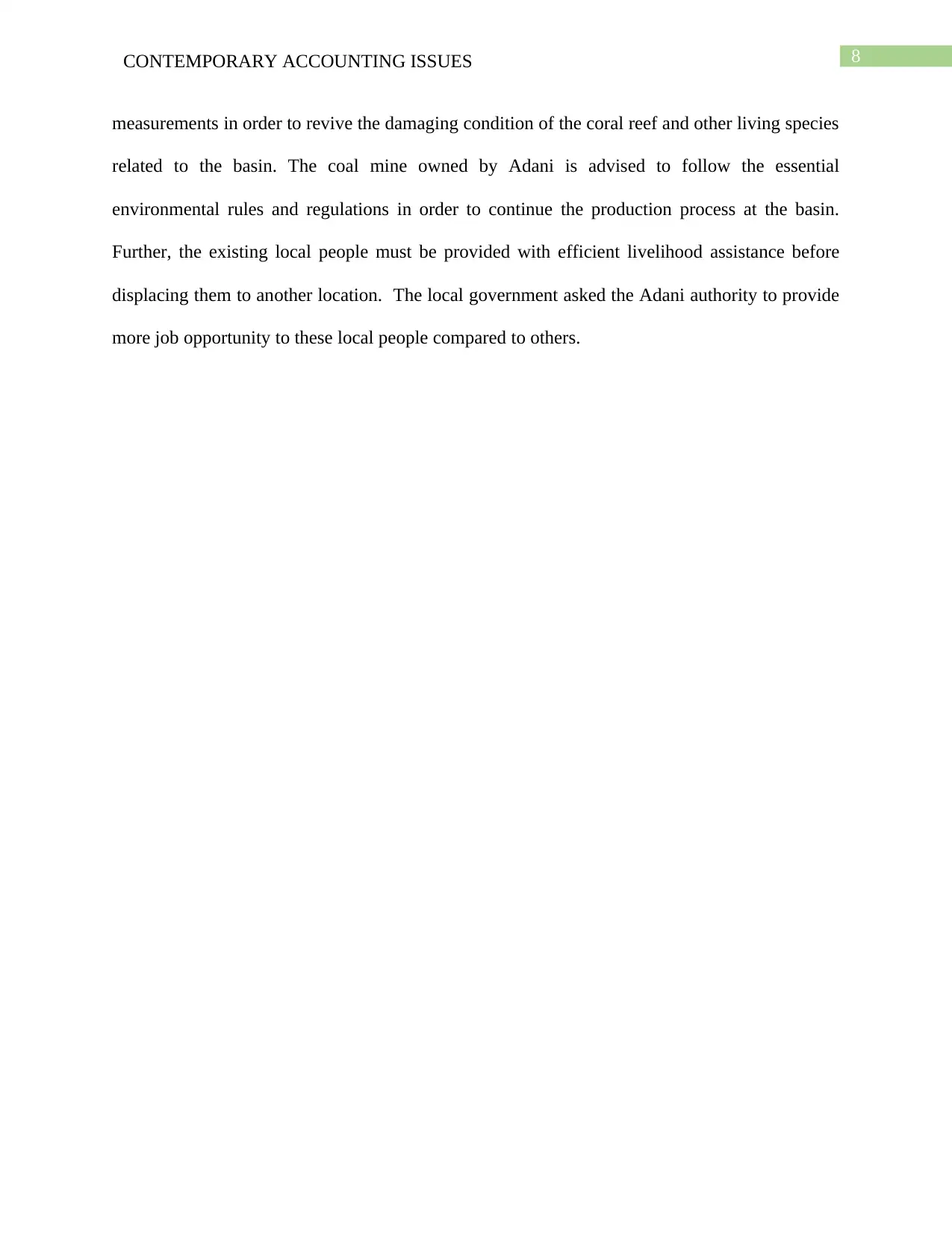
8CONTEMPORARY ACCOUNTING ISSUES
measurements in order to revive the damaging condition of the coral reef and other living species
related to the basin. The coal mine owned by Adani is advised to follow the essential
environmental rules and regulations in order to continue the production process at the basin.
Further, the existing local people must be provided with efficient livelihood assistance before
displacing them to another location. The local government asked the Adani authority to provide
more job opportunity to these local people compared to others.
measurements in order to revive the damaging condition of the coral reef and other living species
related to the basin. The coal mine owned by Adani is advised to follow the essential
environmental rules and regulations in order to continue the production process at the basin.
Further, the existing local people must be provided with efficient livelihood assistance before
displacing them to another location. The local government asked the Adani authority to provide
more job opportunity to these local people compared to others.
⊘ This is a preview!⊘
Do you want full access?
Subscribe today to unlock all pages.

Trusted by 1+ million students worldwide
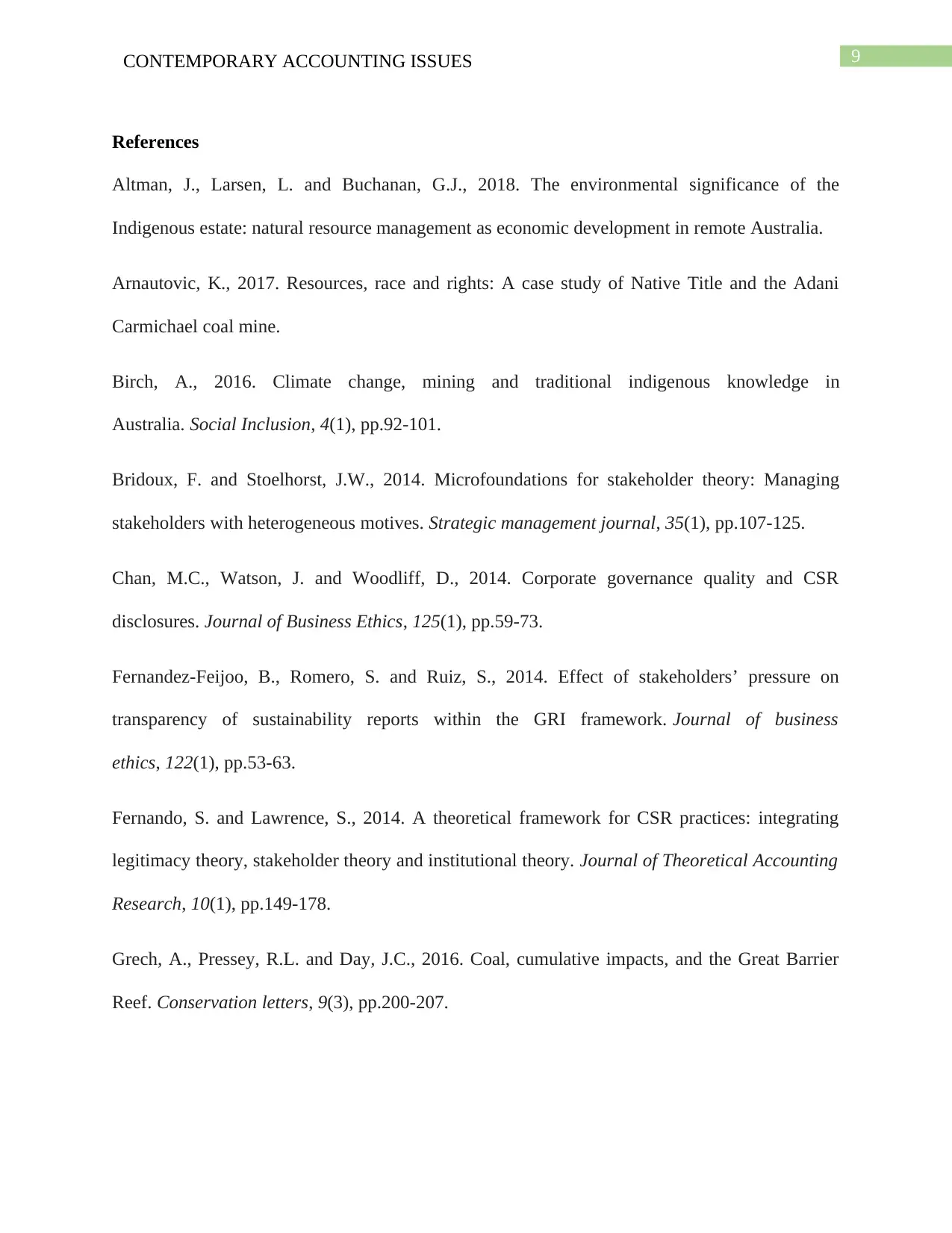
9CONTEMPORARY ACCOUNTING ISSUES
References
Altman, J., Larsen, L. and Buchanan, G.J., 2018. The environmental significance of the
Indigenous estate: natural resource management as economic development in remote Australia.
Arnautovic, K., 2017. Resources, race and rights: A case study of Native Title and the Adani
Carmichael coal mine.
Birch, A., 2016. Climate change, mining and traditional indigenous knowledge in
Australia. Social Inclusion, 4(1), pp.92-101.
Bridoux, F. and Stoelhorst, J.W., 2014. Microfoundations for stakeholder theory: Managing
stakeholders with heterogeneous motives. Strategic management journal, 35(1), pp.107-125.
Chan, M.C., Watson, J. and Woodliff, D., 2014. Corporate governance quality and CSR
disclosures. Journal of Business Ethics, 125(1), pp.59-73.
Fernandez-Feijoo, B., Romero, S. and Ruiz, S., 2014. Effect of stakeholders’ pressure on
transparency of sustainability reports within the GRI framework. Journal of business
ethics, 122(1), pp.53-63.
Fernando, S. and Lawrence, S., 2014. A theoretical framework for CSR practices: integrating
legitimacy theory, stakeholder theory and institutional theory. Journal of Theoretical Accounting
Research, 10(1), pp.149-178.
Grech, A., Pressey, R.L. and Day, J.C., 2016. Coal, cumulative impacts, and the Great Barrier
Reef. Conservation letters, 9(3), pp.200-207.
References
Altman, J., Larsen, L. and Buchanan, G.J., 2018. The environmental significance of the
Indigenous estate: natural resource management as economic development in remote Australia.
Arnautovic, K., 2017. Resources, race and rights: A case study of Native Title and the Adani
Carmichael coal mine.
Birch, A., 2016. Climate change, mining and traditional indigenous knowledge in
Australia. Social Inclusion, 4(1), pp.92-101.
Bridoux, F. and Stoelhorst, J.W., 2014. Microfoundations for stakeholder theory: Managing
stakeholders with heterogeneous motives. Strategic management journal, 35(1), pp.107-125.
Chan, M.C., Watson, J. and Woodliff, D., 2014. Corporate governance quality and CSR
disclosures. Journal of Business Ethics, 125(1), pp.59-73.
Fernandez-Feijoo, B., Romero, S. and Ruiz, S., 2014. Effect of stakeholders’ pressure on
transparency of sustainability reports within the GRI framework. Journal of business
ethics, 122(1), pp.53-63.
Fernando, S. and Lawrence, S., 2014. A theoretical framework for CSR practices: integrating
legitimacy theory, stakeholder theory and institutional theory. Journal of Theoretical Accounting
Research, 10(1), pp.149-178.
Grech, A., Pressey, R.L. and Day, J.C., 2016. Coal, cumulative impacts, and the Great Barrier
Reef. Conservation letters, 9(3), pp.200-207.
Paraphrase This Document
Need a fresh take? Get an instant paraphrase of this document with our AI Paraphraser
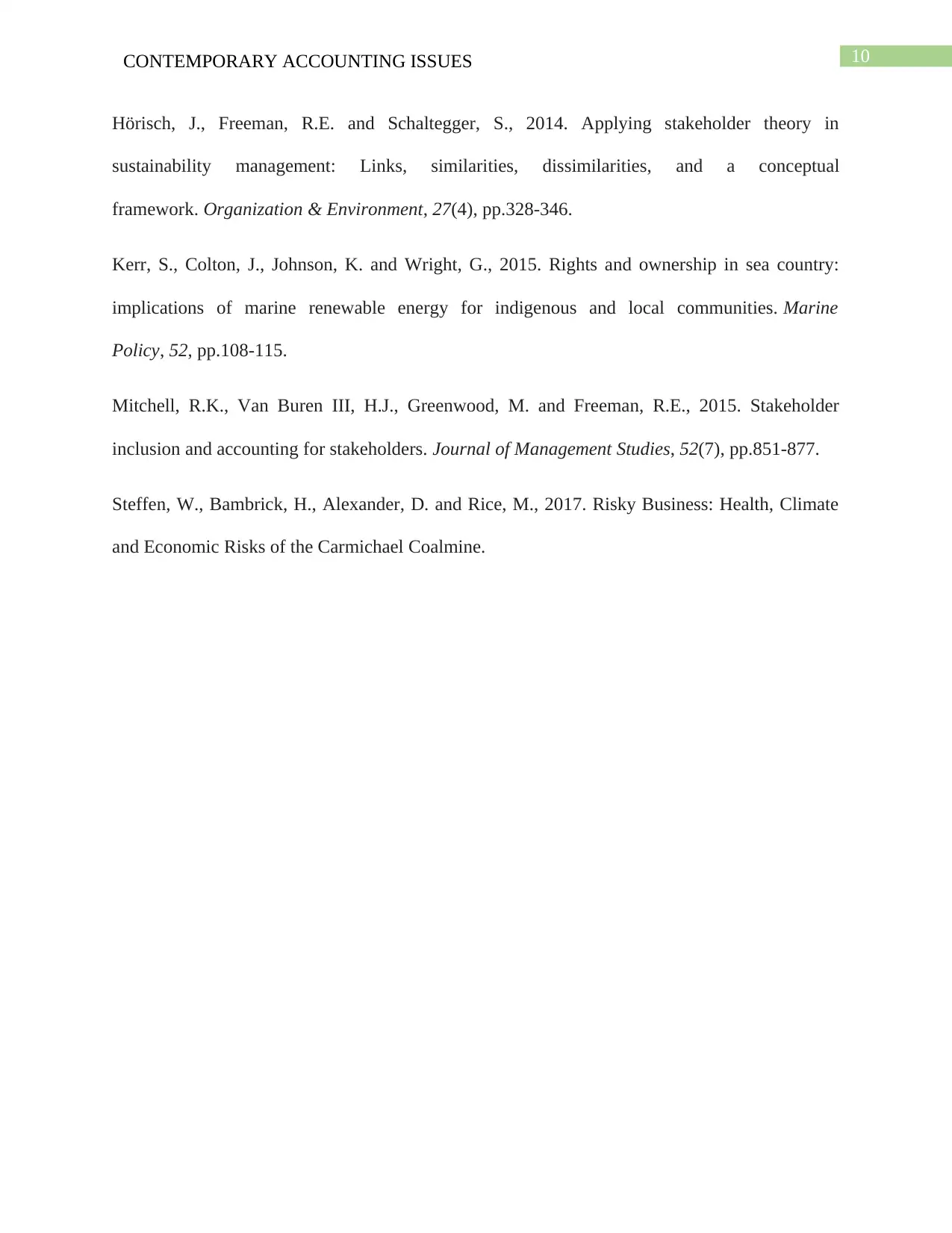
10CONTEMPORARY ACCOUNTING ISSUES
Hörisch, J., Freeman, R.E. and Schaltegger, S., 2014. Applying stakeholder theory in
sustainability management: Links, similarities, dissimilarities, and a conceptual
framework. Organization & Environment, 27(4), pp.328-346.
Kerr, S., Colton, J., Johnson, K. and Wright, G., 2015. Rights and ownership in sea country:
implications of marine renewable energy for indigenous and local communities. Marine
Policy, 52, pp.108-115.
Mitchell, R.K., Van Buren III, H.J., Greenwood, M. and Freeman, R.E., 2015. Stakeholder
inclusion and accounting for stakeholders. Journal of Management Studies, 52(7), pp.851-877.
Steffen, W., Bambrick, H., Alexander, D. and Rice, M., 2017. Risky Business: Health, Climate
and Economic Risks of the Carmichael Coalmine.
Hörisch, J., Freeman, R.E. and Schaltegger, S., 2014. Applying stakeholder theory in
sustainability management: Links, similarities, dissimilarities, and a conceptual
framework. Organization & Environment, 27(4), pp.328-346.
Kerr, S., Colton, J., Johnson, K. and Wright, G., 2015. Rights and ownership in sea country:
implications of marine renewable energy for indigenous and local communities. Marine
Policy, 52, pp.108-115.
Mitchell, R.K., Van Buren III, H.J., Greenwood, M. and Freeman, R.E., 2015. Stakeholder
inclusion and accounting for stakeholders. Journal of Management Studies, 52(7), pp.851-877.
Steffen, W., Bambrick, H., Alexander, D. and Rice, M., 2017. Risky Business: Health, Climate
and Economic Risks of the Carmichael Coalmine.

11CONTEMPORARY ACCOUNTING ISSUES
References
References
⊘ This is a preview!⊘
Do you want full access?
Subscribe today to unlock all pages.

Trusted by 1+ million students worldwide
1 out of 12
Related Documents
Your All-in-One AI-Powered Toolkit for Academic Success.
+13062052269
info@desklib.com
Available 24*7 on WhatsApp / Email
![[object Object]](/_next/static/media/star-bottom.7253800d.svg)
Unlock your academic potential
Copyright © 2020–2025 A2Z Services. All Rights Reserved. Developed and managed by ZUCOL.





